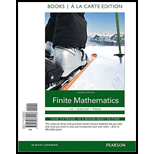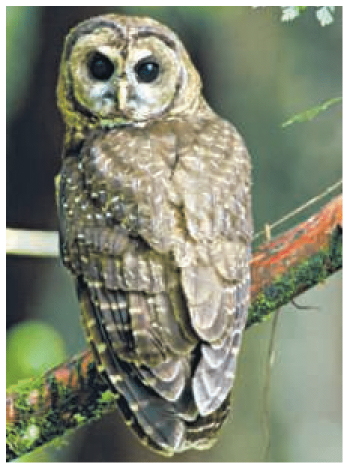
Concept explainers
Northern Spotted Owl Population In an attempt to save the endangered northern spotted owl, the U.S, Fish and Wildlife Service imposed strict guidelines for the use of 12 million acres of Pacific Northwest forest. This decision led to a national debate between the logging industry and environmentalists. Mathematical ecologists have created a mathematical model to analyze population dynamics of the northern spotted owl by dividing the female owl population into three categories: juvenile (up to 1 year old), subadult (1 to 2 years), and adult (over 2 years old). By analyzing these three subgroups, it is possible to use the number of females in each subgroup at time n to estimate the number of females in each group at any time n + 1 with the following matrix equation:
where jn is the number of juveniles, sn is the number of sub-adults, and an is the number of adults at time n. Source: Conservation Biology.
(a) If there are currently 4000 female northern spotted owls made up of 900 juveniles, 500 subadults, and 2600 adults, use a graphing calculator or spreadsheet and matrix operations to determine the total number of female owls for each of the next 5 years. (Hint: Round each answer to the nearest whole number after each matrix multiplication.)

(b) With advanced techniques from
What can we conclude about the long-term survival of the northern spotted owl?
(c) Notice that only 18 percent of the juveniles become sub-adults. Assuming that, through better habitat management, this number could be increased to 40 percent, rework part (a). Discuss possible reasons why only 18 percent of the juveniles become subadults. Under the new assumption, what can you conclude about the long-term survival of the northern spotted owl?
Want to see the full answer?
Check out a sample textbook solution
Chapter 2 Solutions
Finite Mathematics, Books a la Carte Plus MyLab Math Access Card Package (11th Edition)
- This figure is made up of a rectangle and parallelogram. What is the area of this figure? Enter your answer in the box. Do not round any side lengths.arrow_forwardPlease ensure that all parts of the question are answered thoroughly and clearly. Include a diagram to help explain answers. Make sure the explanation is easy to follow. Would appreciate work done written on paper. Thank you.arrow_forward6.54 Let Y₁, Y2,..., Y, be independent Poisson random variables with means 1, 2,..., An respectively. Find the a probability function of Y. b conditional probability function of Y₁, given that Y = m. Y₁ = m. c conditional probability function of Y₁+Y2, given that 6.55 Customers arrive at a department store checkout counter according to a Poisson distribution with a mean of 7 per hour. In a given two-hour period, what is the probability that 20 or more customers will arrive at the counter? 6.56 The length of time necessary to tune up a car is exponentially distributed with a mean of .5 hour. If two cars are waiting for a tune-up and the service times are independent, what is the probability that the total time for the two tune-ups will exceed 1.5 hours? [Hint: Recall the result of Example 6.12.] 6.57 Let Y, Y2,..., Y,, be independent random variables such that each Y, has a gamma distribution with parameters a, and B. That is, the distributions of the Y's might have different a's, but…arrow_forward
- Please ensure that all parts of the question are answered thoroughly and clearly. Include a diagram to help explain answers. Make sure the explanation is easy to follow. Would appreciate work done written on paper. Thank you.arrow_forward6.82 6.83 6.84 6.85 *6.86 6.87 If Y is a continuous random variable and m is the median of the distribution, then m is such that P(Ym) = P(Y ≥ m) = 1/2. If Y₁, Y2,..., Y, are independent, exponentially dis- tributed random variables with mean ẞ and median m, Example 6.17 implies that Y(n) = max(Y₁, Y., Y) does not have an exponential distribution. Use the general form of FY() (y) to show that P(Y(n) > m) = 1 - (.5)". Refer to Exercise 6.82. If Y₁, Y2,..., Y,, is a random sample from any continuous distribution with mean m, what is P(Y(n) > m)? Refer to Exercise 6.26. The Weibull density function is given by -my" m-le-y/a f(y)= α 0. y > 0, elsewhere, where a and m are positive constants. If a random sample of size n is taken from a Weibull distributed population, find the distribution function and density function for Y(1) = min(Y1, Y2,Y). Does Y(1) = have a Weibull distribution? Let Y₁ and Y2 be independent and uniformly distributed over the interval (0, 1). Find P(2Y(1) 0, elsewhere,…arrow_forwardWhich of the functions shown below is differentiable at = 0? Select the correct answer below: -7-6-5-4- -6-5-4-3-21, -7-6-5-4-3-2 -7-6-5-4-3-2-1 2 4 5 6 -1arrow_forward
- Rafael needs to make a total of 50 deliveries this week. So far he has completed 28 of them. What percentage of his total deliveries has Rafael completed?arrow_forwardPlease ensure that all parts of the question are answered thoroughly and clearly. Include a diagram to help explain answers. Make sure the explanation is easy to follow. Would appreciate work done written on paper. Thank you.arrow_forwardA study investigating a new test for diagnosing acute myocardial infarction (AMI) has just been initiated. The sensitivity of the test is estimated at 75% and the specificity at 80%. The study enrolls 600 patients, of whom 200 are confirmed AMI cases as determined by the diagnostic gold standard. How many false negatives are to be expected in the study? A. 50 B. 80 C. 120 D. 150 E. 400arrow_forward
- choose the correct graph belowarrow_forward6.26 The Weibull density function is given by e-y/a f(y) = α 0. y > 0, elsewhere, where a and m are positive constants. This density function is often used as a model for the lengths of life of physical systems. Suppose Y has the Weibull density just given. Find a the density function of UY". b E(Y) for any positive integer k. 6.27 Let Y have an exponential distribution with mean ẞ. 6.28 6.29 a Prove that W = √Y has a Weibull density with α = ẞ and m = 2. b Use the result in Exercise 6.26(b) to give E(Yk/2) for any positive integer k. Let Y have a uniform (0, 1) distribution. Show that U = -2ln(Y) has an exponential distri- bution with mean 2. The speed of a molecule in a uniform gas at equilibrium is a random variable V whose density function is given by 6.30 6.31 6.32 f(v) = av²e-by², v > 0, where b = m/2kT and k, T, and m denote Boltzmann's constant, the absolute temperature, and the mass of the molecule, respectively. a Derive the distribution of W = mV2/2, the kinetic energy of…arrow_forwardcorrect answer is Acould you please show me how to compute using the residue theoremarrow_forward
